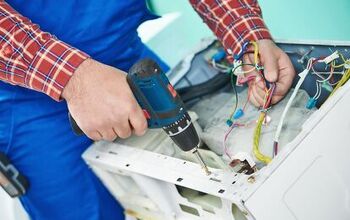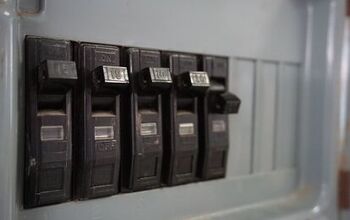What Size Wire Is Needed For 60-Amp Breaker? (Find Out Now!)

Your circuit breaker is a crucial part of your electrical panel that functions as a safety precaution should too much power pass through the wires. Rather than letting the power surge through the wire, it will temporarily shut off to protect the breaker and the electrical panel.
The correct size for your circuit breaker wiring will depend on how many amperes (amps) the breaker is designed to hold. For larger appliances, you will need a 60-amp breaker to ensure it can consistently handle the stronger flow of electricity.
Technically speaking, you should use a 4-gauge wire for a 60-amp circuit breaker. A 6-gauge wire, which is the next gauge, is suitable for up to 55 amps. However, some 60-amp circuit breakers still use a 6-gauge wire because many appliances that are rated for a 60-amp breaker rarely ever draws the full 60 amps.
Different household items require different circuit breakers and wire gauges, so it is important to know which one is required for your own. That’s why we are here to give you a better understanding of how the wiring will work with your breaker.
Do You Need Electricial Wiring or Panel Upgrade Services?
Get free, zero-commitment quotes from pro contractors near you.

More About Circuit Breakers
Circuit breakers are installed into the electrical panel with each circuit attached directly to a singular breaker. Its purpose is to keep an eye on the circuit and “trip” or shut off in the case of an electrical overload.
This will often happen if your appliances are drawing more power than the wire gauge can handle or if too many circuits are plugged into a single circuit.
About Wire Gauges
The size of circuit breaker wires is determined by the American Wire Gauge (AWG) index. The different gauges indicate the diameter or heaviness of the wires. A smaller number relates to a heavier wire, which means it can carry higher electrical currents.
That said, if you ever need to upgrade your circuit breaker amps, you will have to change the wiring out. Here are the common gauge wires that are installed in residential properties and the most common uses.
Wire Gauge | Amps | Common Uses |
14-Gauge | 15 amps | Light fixtures in living rooms and hallways |
12-Gauge | 20 amps | Light fixtures in bathrooms and kitchens |
10-Gauge | 30 amps | Household appliances; ex. Clothes dryers, window-mounted AC units, etc. |
8-Gauge | 40 amps | Medium appliances; ex. AC systems, electric kitchen range, etc. |
6-Gauge | 55 amps | Large appliances; air conditioners, electric furnaces, etc. |
4-Gauge | 60 amps | Large appliances; electric heaters, larger electric furnaces, etc. |
Risks of Using the Wrong Size Wire
An incorrectly sized wire can negatively impact the electrical wires themselves and put your entire home at risk. There are many issues that can occur, ranging from minor annoyances to expensive replacements to potential hazards to your family.
Melted Electrical Wires
If your wiring is too small, it will begin to melt due to the voltage of the current flowing through it. These smaller wires have a higher resistance to the flow of energy. That high resistance creates more heat, which in turn can completely fry the wire.
House Fires
If these wiring issues persist and get too intense, it can eventually lead to a house fire. Wires that are sized too small cannot handle the electrical current put out by a breaker with higher amperage, which will lead to them overheating, melting, and sparking.
Circuit Breaker Damage
The wrong size wires can cause short circuits, which will lead to damage to your circuit breaker itself. More than anything, this will lead to more costly repairs down the road.
Extra Frustrations and Expenses
When you hear about using wires that are not sized correctly, most of the warnings are about the wires being too small. However, wires that are too large can become an issue, too. If the wire is too large, it will be difficult to handle and connect. Moreover, it will be more expensive to use over time.
Related Questions
What is the average lifespan of a circuit breaker?
The average circuit breaker’s lifespan can be anywhere from 15 to 40 years depending on how many breaker trips happen over the years and due to general wear and tear.
What are some common problems that can occur due to a faulty breaker?
Ongoing issues with your circuit breaker can impact different areas throughout your home. Some problems you will have to deal with include breaker failure without any trips, breaker trips with nothing plugged in, flickering lights, electrical fires, electric shock, and more.
What are amps, volts, and watts?
These three terms refer to different measurements relating to electrical currents. Amps measure the electrical charge that flows through the wires in one second. Volts measure the strength of the electricity being pushed through the circuit. Watts measure the amount of electrical power that any given device uses.
Do You Need Electricial Wiring or Panel Upgrade Services?
Get free, zero-commitment quotes from pro contractors near you.

Final Thoughts
When it comes to determining the correct size wire for your 60-amp breaker, there are technically two right answers. The first option is to use a 4-gauge wire and play it safe.
However, you can also use a 6-gauge wire for appliances that are rated for 60 amps but won’t necessarily max out that current. And if you’re not sure, you can always talk to a local electrician and get their advice.
Related Guide

I am a copywriter and editor based in the Las Vegas area with nearly a decade of experience under my belt writing landing pages, cost guides, blog posts, newsletters, case studies, and social media content. I have a degree in Strategic Communication and experience working in both the account and creative spheres. My goal is to always be discovering new interests and bettering myself as a writer and editor along the way.
More by Kerry Souder



























